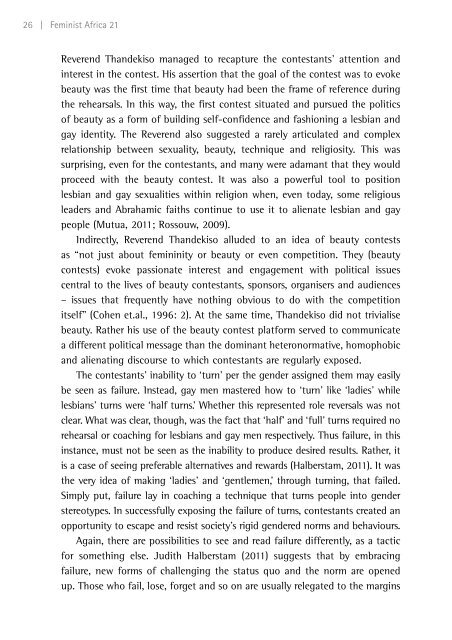The politics of fashion and beauty in Africa
fa21_proof_3
fa21_proof_3
Create successful ePaper yourself
Turn your PDF publications into a flip-book with our unique Google optimized e-Paper software.
26 | Fem<strong>in</strong>ist <strong>Africa</strong> 21<br />
Reverend Th<strong>and</strong>ekiso managed to recapture the contestants’ attention <strong>and</strong><br />
<strong>in</strong>terest <strong>in</strong> the contest. His assertion that the goal <strong>of</strong> the contest was to evoke<br />
<strong>beauty</strong> was the first time that <strong>beauty</strong> had been the frame <strong>of</strong> reference dur<strong>in</strong>g<br />
the rehearsals. In this way, the first contest situated <strong>and</strong> pursued the <strong>politics</strong><br />
<strong>of</strong> <strong>beauty</strong> as a form <strong>of</strong> build<strong>in</strong>g self-confidence <strong>and</strong> <strong>fashion</strong><strong>in</strong>g a lesbian <strong>and</strong><br />
gay identity. <strong>The</strong> Reverend also suggested a rarely articulated <strong>and</strong> complex<br />
relationship between sexuality, <strong>beauty</strong>, technique <strong>and</strong> religiosity. This was<br />
surpris<strong>in</strong>g, even for the contestants, <strong>and</strong> many were adamant that they would<br />
proceed with the <strong>beauty</strong> contest. It was also a powerful tool to position<br />
lesbian <strong>and</strong> gay sexualities with<strong>in</strong> religion when, even today, some religious<br />
leaders <strong>and</strong> Abrahamic faiths cont<strong>in</strong>ue to use it to alienate lesbian <strong>and</strong> gay<br />
people (Mutua, 2011; Rossouw, 2009).<br />
Indirectly, Reverend Th<strong>and</strong>ekiso alluded to an idea <strong>of</strong> <strong>beauty</strong> contests<br />
as “not just about fem<strong>in</strong><strong>in</strong>ity or <strong>beauty</strong> or even competition. <strong>The</strong>y (<strong>beauty</strong><br />
contests) evoke passionate <strong>in</strong>terest <strong>and</strong> engagement with political issues<br />
central to the lives <strong>of</strong> <strong>beauty</strong> contestants, sponsors, organisers <strong>and</strong> audiences<br />
– issues that frequently have noth<strong>in</strong>g obvious to do with the competition<br />
itself” (Cohen et.al., 1996: 2). At the same time, Th<strong>and</strong>ekiso did not trivialise<br />
<strong>beauty</strong>. Rather his use <strong>of</strong> the <strong>beauty</strong> contest platform served to communicate<br />
a different political message than the dom<strong>in</strong>ant heteronormative, homophobic<br />
<strong>and</strong> alienat<strong>in</strong>g discourse to which contestants are regularly exposed.<br />
<strong>The</strong> contestants’ <strong>in</strong>ability to ‘turn’ per the gender assigned them may easily<br />
be seen as failure. Instead, gay men mastered how to ‘turn’ like ‘ladies’ while<br />
lesbians’ turns were ‘half turns.’ Whether this represented role reversals was not<br />
clear. What was clear, though, was the fact that ‘half’ <strong>and</strong> ‘full’ turns required no<br />
rehearsal or coach<strong>in</strong>g for lesbians <strong>and</strong> gay men respectively. Thus failure, <strong>in</strong> this<br />
<strong>in</strong>stance, must not be seen as the <strong>in</strong>ability to produce desired results. Rather, it<br />
is a case <strong>of</strong> see<strong>in</strong>g preferable alternatives <strong>and</strong> rewards (Halberstam, 2011). It was<br />
the very idea <strong>of</strong> mak<strong>in</strong>g ‘ladies’ <strong>and</strong> ‘gentlemen,’ through turn<strong>in</strong>g, that failed.<br />
Simply put, failure lay <strong>in</strong> coach<strong>in</strong>g a technique that turns people <strong>in</strong>to gender<br />
stereotypes. In successfully expos<strong>in</strong>g the failure <strong>of</strong> turns, contestants created an<br />
opportunity to escape <strong>and</strong> resist society’s rigid gendered norms <strong>and</strong> behaviours.<br />
Aga<strong>in</strong>, there are possibilities to see <strong>and</strong> read failure differently, as a tactic<br />
for someth<strong>in</strong>g else. Judith Halberstam (2011) suggests that by embrac<strong>in</strong>g<br />
failure, new forms <strong>of</strong> challeng<strong>in</strong>g the status quo <strong>and</strong> the norm are opened<br />
up. Those who fail, lose, forget <strong>and</strong> so on are usually relegated to the marg<strong>in</strong>s



